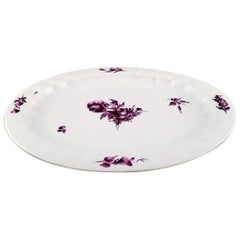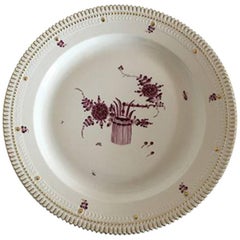Royal Copenhagen Purpur
Antique 1870s Danish Neoclassical Porcelain
Antique 1870s Danish Neoclassical Porcelain
Recent Sales
Mid-20th Century Danish Neoclassical Platters and Serveware
Porcelain
A Close Look at Neoclassical Furniture
Neoclassical design emerged in Europe in the 1750s, as the Age of Enlightenment reached full flower. Neoclassical furniture took its cues from the styles of ancient Rome and Athens: symmetrical, ordered, dignified forms with such details as tapered and fluted chair and table legs, backrest finials and scrolled arms.
Over a period of some 20 years, first in France and later in Britain, neoclassical design — also known as Louis XVI, or Louis Seize — would supersede the lithe and curvaceous Rococo or Louis XV style.
The first half of the 18th century had seen a rebirth of interest in classical antiquity. The "Grand Tour" of Europe, codified as a part of the proper education of a patrician gentleman, included an extended visit to Rome. Some ventured further, to sketch the ruins of ancient Greece. These drawings and others — particularly those derived from the surprising and rich archaeological discoveries in the 1730s and ’40s at the sites of the Roman cities of Pompeii and Herculaneum — caused great excitement among intellectuals and aesthetes alike.
Neoclassical furniture is meant to reflect both grace and power. The overall appearance of neoclassical chairs, tables and cabinetry is strong and rectilinear. These pieces are, in effect, classical architecture in miniature: chair and table legs are shaped like columns; cabinets are constructed with elements that mirror friezes and pediments.
Yet neoclassicism is enlivened by gilt and silver leaf, marquetry, and carved and applied ornamental motifs based on Greek and Roman sculpture: acanthus leaves, garlands, laurel wreaths, sheaves of arrow, medallions and chair splats are carved in the shapes of lyres and urns. Ormolu — or elaborate bronze gilding — was essential to French design in the 18th and 19th centuries as a cornerstone of the neoclassical and Empire styles.
As you can see from the furniture on these pages, there is a bit of whimsy in such stately pieces — a touch of lightness that will always keep neoclassicism fresh.
Find antique neoclassical furniture today on 1stDibs.
Finding the Right Dining-entertaining for You
Your dining room table is a place where stories are shared and personalities shine — why not treat yourself and your guests to the finest antique and vintage glass, silver, ceramics and serveware for your meals?
Just like the people who sit around your table, your serveware has its own stories and will help you create new memories with your friends and loved ones. From ceramic pottery to glass vases, set your table with serving pieces that add even more personality, color and texture to your dining experience.
Invite serveware from around the world to join your table settings. For special occasions, dress up your plates with a striking Imari charger from 19th-century Japan or incorporate Richard Ginori’s Italian porcelain plates into your dining experience. Celebrate the English ritual of afternoon tea with a Japanese tea set and an antique Victorian kettle. No matter how big or small your dining area is, there is room for the stories of many cultures and varied histories, and there are plenty of ways to add pizzazz to your meals.
Add different textures and colors to your table with dinner plates and pitchers of ceramic and silver or a porcelain lidded tureen, a serving dish with side handles that is often used for soups. Although porcelain and ceramic are both made in a kiln, porcelain is made with more refined clay and is more durable than ceramic because it is denser. The latter is ideal for statement pieces — your tall mid-century modern ceramic vase is a guaranteed conversation starter. And while your earthenware or stoneware is maybe better suited to everyday lunches as opposed to the fine bone china you’ve reserved for a holiday meal, handcrafted studio pottery coffee mugs can still be a rich expression of your personal style.
“My motto is ‘Have fun with it,’” says author and celebrated hostess Stephanie Booth Shafran. “It’s yin and yang, high and low, Crate & Barrel with Christofle silver. I like to mix it up — sometimes in the dining room, sometimes on the kitchen banquette, sometimes in the loggia. It transports your guests and makes them feel more comfortable and relaxed.”
Introduce elegance at supper with silver, such as a platter from celebrated Massachusetts silversmith manufacturer Reed and Barton or a regal copper-finish flatware set designed by International Silver Company, another New England company that was incorporated in Meriden, Connecticut, in 1898. By then, Meriden had already earned the nickname “Silver City” for its position as a major hub of silver manufacturing.
At the bar, try a vintage wine cooler to keep bottles cool before serving or an Art Deco decanter and whiskey set for after-dinner drinks — there are many possibilities and no wrong answers for tableware, barware and serveware. Explore an expansive collection of antique and vintage glass, ceramics, silver and serveware today on 1stDibs.
- 1stDibs ExpertNovember 4, 2024To identify a Royal Copenhagen pattern, first examine the backstamp on your piece. The official Royal Copenhagen website has a reference guide that you can use to determine the year of your piece's production based on this stamp. From there, you can search the pattern resource on the official website for that year and find out the name of your Royal Copenhagen pattern. Find a collection of Royal Copenhagen china on 1stDibs.
- 1stDibs ExpertAugust 20, 2024To tell Royal Copenhagen seconds, locate the maker's mark. You'll usually find it on the bottom of pieces. If you see a fine vertical line cut into the three lines of the maker's arched logo, your piece is likely a second, meaning that it didn't meet Royal Copenhagen's quality standards at the time of production. Because the line can be very faint, it may be helpful to use a magnifying glass when examining your piece. Shop a large collection of Royal Copenhagen porcelain wares on 1stDibs.
- 1stDibs ExpertApril 5, 2022Yes, Royal Copenhagen is still in business but the company has undergone many buy-outs and acquisitions over the years. Originally founded in Copenhagen in 1775, the company imitated the exquisite china from the Ming and Qing dynasties. Royal patronage and top-quality craftsmanship quickly earned the brand a reputation, making its products quite collectible. On 1stDibs, find a collection of authentic Royal Copenhagen plates and other pieces from some of the world’s top sellers.
- 1stDibs ExpertApril 5, 2022Yes, Royal Copenhagen still produces some figurines. However, most of the manufacturer's most well-known lines are no longer in production. As of January 2022, only the annual figurines are still currently in production. Today, Royal Copenhagen is a brand owned by Fiskars Group rather than an independent company. You'll find a collection of Royal Copenhagen figurines on 1stDibs.


